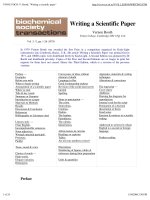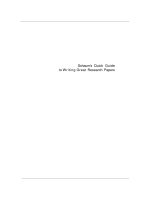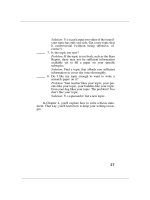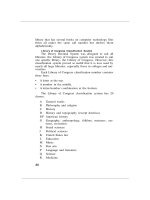Workshop on writing a research paper
Bạn đang xem bản rút gọn của tài liệu. Xem và tải ngay bản đầy đủ của tài liệu tại đây (4.21 MB, 41 trang )
<span class="text_page_counter">Trang 4</span><div class="page_container" data-page="4">
<b>Research Article: Main section-Purpose-Length (adapted from Nguyen, 2023)</b>
</div><span class="text_page_counter">Trang 5</span><div class="page_container" data-page="5"><b>1. A GOOD Research Paper Title</b>
<b>• Length: 8-15 words.</b>
• Core components: (a) the topic, (b) the method, (c) the sample, and (d) the results of your study. Basic structure of a research title:
[Result]: A [method] study of [topic] among [sample].
e.g.: [Meditation Makes Nurses Perform Better]: A [Qualitative] Study of [Mindfulness Meditation] among [German Nursing Students] (Enargo Academy, 2023).
[Main theme or research topic]: [Research design] + [sample] + [geographical area].
e.g.: [“English As a Symbol of Internationalization in Higher Education]: [A Case Study] of [Vietnam]” (Duong & Chua, 2016, as cited in Nguyen,
Sources: Nguyen, H. C. (2023). Training Course: Writing a journal article. Slide show; Enargo Academy. (2023). Six important tips of writing a
</div><span class="text_page_counter">Trang 6</span><div class="page_container" data-page="6"><b>2. A GOOD Research Paper Abstract</b>
<b>• a short summary or preview of a paper with 150-250 words.</b>
• A model abstract and example of 5 parts adapted from Hyland (2007, as cited in Russo, 2020):
Sources: Russo, (2023). Abstract
<i>Section to Research Papers. San José </i>
<i>State University Writing Center.</i>
</div><span class="text_page_counter">Trang 7</span><div class="page_container" data-page="7"><b>2. A GOOD Research Paper Abstract: Useful Phrases </b>
<i>The study contributes…</i>
Sources: Nguyen, H. C. (2023). Training Course: Writing a journal article. Slide show.
</div><span class="text_page_counter">Trang 8</span><div class="page_container" data-page="8"><b>Identifying the training needs of Heads of Department in a newly established university in Vietnam</b>
Although middle-level academic managers really need training in order to perform their roles adequately in the very changing context of higher education, little formal training is provided, particularly in less developed
countries <b>(background)</b>. This paper identifies the training needs of Heads of Department in a newly established university in Vietnam as a first step in preparing a professional development program for them that might fill this gap <b>(purpose)</b>. Through document analysis and interviews with 24 participants, the study finds that the Heads of Department have the most critical training needs in generic management knowledge and skills, the roles of the Heads of Department, English language proficiency, research methods skills and practice <b>(method + findings)</b>. They also have a need to improve their communication and planning skills. These results both confirm and
contradict previous studies on Department Heads’ training needs from developed Western universities <b>(finding)</b>. The paper concludes that the Department Heads’ training needs are both context-based and
competencies-biased <b>(conclusion)</b>. <i>(152 words)</i>
<b>2. A GOOD Research Paper Abstract: EXAMPLE #1 (Nguyen, 2023)</b>
<i>Source: Nguyen, T. L. H. (2012). Identifying the training needs of Heads of Department in a newly established university in Vietnam. Journal </i>
<i>of Higher Education Policy and Management, 34(3), 309-321.</i>
</div><span class="text_page_counter">Trang 9</span><div class="page_container" data-page="9"><b>English as a symbol of internationalization in higher education: a case study of Vietnam</b>
Vietnam universities have experienced remarkable changes brought about by their internationalization policies. The switch to English as a medium of instruction (EMI) for some academic programs was one of these critical changes. Literature has
reported numerous issues related to EMI, including inadequate language proficiency of teaching staff <b>(background)</b>. This paper looks at a qualitative research study on how a government university from Vietnam employs different strategies to
enhance teachers’ English proficiency <b>(purpose + method)</b>. The study reveals that the introduction of new supporting systems, assessment bodies, recruitment criteria and institutional strategies on training, monitoring and motivation have created cultural change within the teacher community <b>(findings)</b>. This cultural change, which includes elements such as self-directed learning, peer learning, professionalism, and ‘open-to-change’ attitudes, has been perceived by both leaders and teachers to be
conducive to teachers’ language learning <b>(conclusion)</b>. The findings presented in this paper seek to contribute to the
formulation or adjustment of policies related to educational reforms, such as curriculum reform, teacher recruitment and teacher professional development in non-Englishspeaking countries <b>(implication)</b>. (164 words)
<b>2. A GOOD Research Paper Abstract: EXAMPLE #2 (Nguyen, 2023)</b>
<i>Source: Duong, V. A. & Chua, C. S. K. (2016). English as a symbol of internationalization in higher education: a case study of Vietnam. Higher </i>
<i>Education Research & Development, 35(4), 669-683. </i>
</div><span class="text_page_counter">Trang 10</span><div class="page_container" data-page="10"><b>3. A GOOD Research Paper Introduction</b>
•to provide enough information for the reader to be able to understand your argument and
<b>its stakes with 400-800 words.</b>
•A suggested <b>Create a Research Space (CaRS.) structure of an introduction adapted from </b>
Ammon (2023) & Nguyen (2023):
<b>Step 1: </b>
<b>- Establish a territory (the context, background) and/or importance of the topic</b>
<b>- Give a brief review of the relevant academic literature</b>
</div><span class="text_page_counter">Trang 11</span><div class="page_container" data-page="11"><b>3. A GOOD Research Paper Introduction: Useful Phrases (Nguyen, 2023)</b>
• Establishing the context, background and/or importance of the topic
<i>“In recent years, there has been an increasing interest in …”</i>
<i>“In the new global economy, X has become a central issue for …”</i>
• Giving a brief review of the relevant academic literature
<i>“It has previously been observed that …”</i>
<i>“Studies over the past two decades have provided important information on …”</i>
• Presenting a problem, controversy or a knowledge gap in the field of study
<i>“Most studies in the field of X have only focused on …”“There has been little quantitative analysis of …”</i>
• Stating the purpose of the study
<i>“This paper analyses the impact of …”</i>
<i>“This research examines the emerging role of X in the context of …”</i>
• Providing an overview of the coverage and/or structure of the article
<i>“This paper begins by … It will then go on to …”</i>
<i>“This paper has been divided into four parts. The first part deals with …”</i>
</div><span class="text_page_counter">Trang 12</span><div class="page_container" data-page="12"><b>3. Quantitative Research Introduction: EXAMPLE #1 (Ammon, 2023) </b>
Source: Ammon, C. (2023). Introduction Section to
<i>Research Papers. San José </i>
<i>State University Writing Center.</i>
</div><span class="text_page_counter">Trang 13</span><div class="page_container" data-page="13"><b>3. Quantitative Research Introduction: EXAMPLE #1 (Ammon, 2023) </b>
Source: Ammon, C. (2023). Introduction Section to
<i>Research Papers. San José </i>
<i>State University Writing Center.</i>
</div><span class="text_page_counter">Trang 14</span><div class="page_container" data-page="14"><b>3. Quantitative Research Introduction: EXAMPLE #1 (Ammon, 2023) </b>
Source: Ammon, C. (2023). Introduction Section to
<i>Research Papers. San José </i>
<i>State University Writing Center.</i>
</div><span class="text_page_counter">Trang 15</span><div class="page_container" data-page="15"><b>3. Qualitative Research Introduction: EXAMPLE #2 (Ammon, 2023) </b>
Source: Ammon, C. (2023). Introduction Section to
<i>Research Papers. San José </i>
<i>State University Writing Center.</i>
</div><span class="text_page_counter">Trang 16</span><div class="page_container" data-page="16"><b>3. Qualitative Research Introduction: EXAMPLE #2 (Ammon, 2023) </b>
Source: Ammon, C. (2023). Introduction Section to
<i>Research Papers. San José </i>
<i>State University Writing Center.</i>
</div><span class="text_page_counter">Trang 17</span><div class="page_container" data-page="17"><b>3. Qualitative Research Introduction: EXAMPLE #2 (Ammon, 2023) </b>
Source: Ammon, C. (2023). Introduction Section to
<i>Research Papers. San José </i>
<i>State University Writing Center.</i>
</div><span class="text_page_counter">Trang 18</span><div class="page_container" data-page="18"><b>3. Qualitative Research Introduction: EXAMPLE #2 (Ammon, 2023) </b>
Source: Ammon, C. (2023). Introduction Section to
<i>Research Papers. San José </i>
<i>State University Writing Center.</i>
</div><span class="text_page_counter">Trang 19</span><div class="page_container" data-page="19"><b>4. A GOOD Research Paper Literature Review (Cantero, 2019)</b>
• a review or discussion of the current published material available on
<b>a particular research topic in APA-referencing format with 800-1,000 </b>
<b>•summarizes, synthesizes</b> and <b>evaluates </b>the ideas of other scholars
<b>on that research topic. </b>
<i>Source: Cantero, C. (2019). How to write a literature review. San José State University Writing Center.</i>
</div><span class="text_page_counter">Trang 20</span><div class="page_container" data-page="20"><b>4. A GOOD Research Paper Literature Review (Cantero, 2019)</b>
<i>literature review. San </i>
<i>José State University Writing Center.</i>
</div><span class="text_page_counter">Trang 21</span><div class="page_container" data-page="21"><b>4. A GOOD Research Paper Literature Review: Citation (Cantero, 2019)</b>
<i>Source: Cantero, C. (2019). How to write a literature review. San José State University Writing Center.</i>
</div><span class="text_page_counter">Trang 22</span><div class="page_container" data-page="22">How to write a literature
<i>review. San José State </i>
<i>University Writing Center.</i>
</div><span class="text_page_counter">Trang 23</span><div class="page_container" data-page="23"><b>5. A GOOD Research Paper Methodology (Chris, 2021)</b>
•Describe how your research was conducted; help increase the reader’s trust in your findings <b>analyses to observe trends, </b>
<b>make predictions , run experiments & test </b>
<b>Qualitative research </b>
(collecting non-numerical data ( from open-ended questionnaire,
interviews, observations) &
<b>identifying patterns in language, </b>
theme, structure among other features to understand human
experiences)
</div><span class="text_page_counter">Trang 24</span><div class="page_container" data-page="24"><b>5. Research Methodology: 4 Steps (Chris, 2021) </b>
<i>Source: Chris, M. J. (2021). Methodology Section for Research Papers. San José State University Writing Center.</i>
1. <b>describing your research question and the type of data </b>you used in answering it,
2. <b>explaining your process of data collection</b>
3. <b>elaborating on data analysis</b>
4. <b>justifying the research design </b>you took
</div><span class="text_page_counter">Trang 25</span><div class="page_container" data-page="25"><b>5. Quantitative Research Methodology: EXAMPLE #1 (Chris, 2021) </b>
</div><span class="text_page_counter">Trang 26</span><div class="page_container" data-page="26"><b>5. Quantitative Research Methodology: EXAMPLE #1 </b>
</div><span class="text_page_counter">Trang 27</span><div class="page_container" data-page="27"><b>5. Quantitative Research Methodology: EXAMPLE #1 </b>
</div><span class="text_page_counter">Trang 28</span><div class="page_container" data-page="28"><b>5. Quantitative Research Methodology: EXAMPLE #1 (Chris, 2021) </b>
</div><span class="text_page_counter">Trang 29</span><div class="page_container" data-page="29"><b>5. Qualitative Research Methodology: EXAMPLE #2 (Chris, 2021) </b>
</div><span class="text_page_counter">Trang 30</span><div class="page_container" data-page="30"><b>5. Qualitative Research Methodology: EXAMPLE #2 (Chris, 2021) </b>
</div><span class="text_page_counter">Trang 31</span><div class="page_container" data-page="31"><b>6. Research Results/Findings: 3 Parts (Ammon, 2022) </b>
<i>Source: Ammon, C. (2022). Results Section for Research Papers. San José State University Writing Center.</i>
• report the findings of the study in connection to the research question(s);
<b>state the facts ONLY; in written text, tables, graphs, and other illustrations with 1,000-1,200 words.</b>
• 3 parts:
<b>1. introduction</b> to connect the results with the research question(s).
<b>2. presenting your findings in a structured way </b>(such as thematically or chronologically), attention to any important, interesting, or significant findings, combining text and visuals.
<b>3. Closing</b> that clearly summarizes the key findings of the study
</div><span class="text_page_counter">Trang 32</span><div class="page_container" data-page="32">•Source: Ammon, C. (2022). Results
<i>Section for Research Papers. San José </i>
<i>State University Writing Center.</i>
<b>6. Quantitative Research Results/Findings: </b>
<b>EXAMPLE #1 (Ammon, 2022) </b>
</div><span class="text_page_counter">Trang 33</span><div class="page_container" data-page="33"><b>6. Quantitative Research Results/Findings: EXAMPLE #1 (Ammon, 2022) </b>
•Comments:
</div><span class="text_page_counter">Trang 34</span><div class="page_container" data-page="34"><b>6. Qualitative Research Results/Findings: </b>
<b>EXAMPLE #2 (Ammon, 2022) </b>
•Source: Ammon, C. (2022). Results
<i>Section for Research Papers. San José </i>
<i>State University Writing Center.</i>
Comments:
Notice that the findings presented by the author are primarily descriptive and focus on the perceptions of
people. The authors are interpreting the commonalities and themes that arose within the study, comparing, and contrasting the stakeholders’ nationalities and opinions to drive conclusions. By clumping shared opinions, the authors have
</div><span class="text_page_counter">Trang 35</span><div class="page_container" data-page="35"><b>7. Research Discussion: 3 Parts (Dunton, 2021) </b>
<i>Source: Dunton, R. (2021). Discussion Section for Research Papers. San José State University Writing Center.</i>
• describes, analyzes, and interprets their findings, why the research results are important and where they fit in the current literature, and stating the shortcomings of the study
<b>with 1,000-1,200 words.</b>
• 6 parts:
<b>1. summarize the key findings </b>from the research and link them to the initial research question.
<b>2. place the findings in context</b>, analyzing how the results fit in with previous research.
<b>3. mention and discuss any unexpected & significant results </b>to the research question.
<b>4. address limitations </b>or weaknesses in the research
5. provide a brief look at potential <b>follow-up research studies</b>.
6. conclude with <b>a restatement of the most significant findings and their implications </b>
(connections with existing literature)
</div><span class="text_page_counter">Trang 36</span><div class="page_container" data-page="36"><b>7. Research Discussion: EXAMPLE (Dunton, 2021) </b>
Source: Dunton, R. (2021). Discussion Section
<i>for Research Papers. San José State </i>
<i>University Writing Center.</i>
Comments:
The sample discussion section was split between a dedicated “Discussion”
section and a section exclusively covering “Limitations.” The authors
<b>presented their key findings and placed them into the context of pre-existing </b>
<b>literature and research. They restated </b>
those findings and then discussed the
<b>limitations of their study, followed by recommendations for future research </b>
that could possibly address or overcome those limitations.
</div><span class="text_page_counter">Trang 37</span><div class="page_container" data-page="37"><b>8. Research Conclusion: 3 Parts (Tablas-Mejia, 2021) </b>
Source: Tablas-Mejia, I. (2021). Conclusion Section for Research Papers. San José State University Writing Center.









